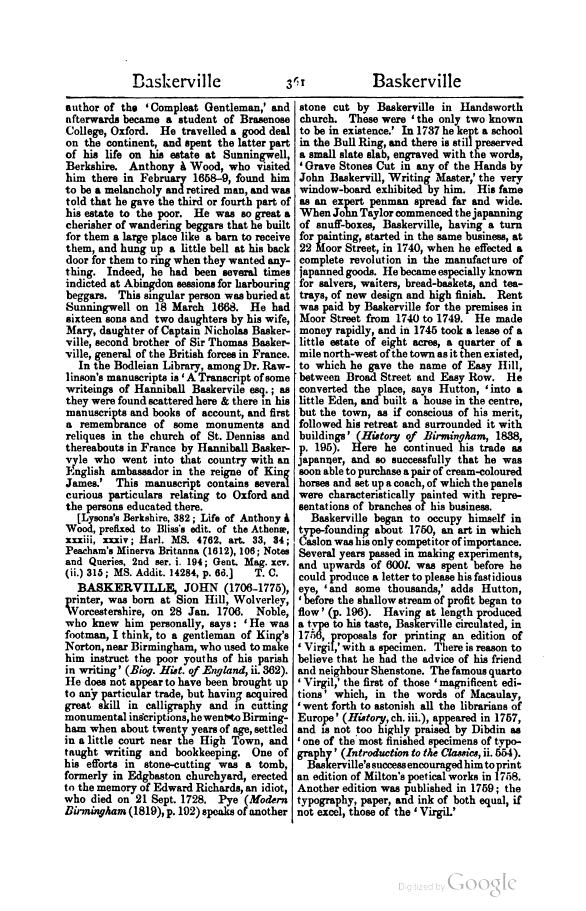author of the ‘Compleat Gentleman,’ and afterwards became a student of Brasenose College, Oxford. He travelled a good deal on the continent, and spent the latter part of his life on his estate at Sunningwell, Berkshire. Anthony à Wood, who visited him there in February 1658–9, found him to be a melancholy and retired man, and was told that he gave the third or fourth part of his estate to the poor. He was so great a cherisher of wandering beggars that he built for them a large place like a barn to receive them, and hung up a little bell at his back door for them to ring when they wanted anything. Indeed, he had been several times indicted at Abingdon sessions for harbouring beggars. This singular person was buried at Sunningwell on 18 March 1668. He had sixteen sons and two daughters by his wife, Mary, daughter of Captain Nicholas Baskerville, second brother of Sir Thomas Baskerville, general of the British forces in France.
In the Bodleian Library, among Dr. Rawlinson's manuscripts is ‘A Transcript of some writeings of Hanniball Baskervile esq.; as they were found scattered here & there in his manuscripts and books of account, and first a remembrance of some monuments and reliques in the church of St. Denniss and thereabouts in France by Hanniball Baskervyle who went into that country with an English ambassador in the reigne of King James.’ This manuscript contains several curious particulars relating to Oxford and the persons educated there.
[Lysons's Berkshire, 382; Life of Anthony à Wood, prefixed to Bliss's edit. of the Athenæ, xxxiii, xxxiv; Harl. MS. 4762, art. 33, 34; Peacham's Minerva Britanna (1612), 106; Notes and Queries, 2nd ser. i. 194; Gent. Mag. xcv. (ii.) 315; MS. Addit. 14284, p. 66.]
BASKERVILLE, JOHN (1706–1775), printer, was born at Sion Hill, Wolverley, Worcestershire, on 28 Jan. 1706. Noble, who knew him personally, says: ‘He was footman, I think, to a gentleman of King's Norton, near Birmingham, who used to make him instruct the poor youths of his parish in writing’ (Biog. Hist. of England, ii. 362). He does not appear to have been brought up to any particular trade, but having acquired great skill in calligraphy and in cutting monumental inscriptions, he went to Birmingham when about twenty years of age, settled in a little court near the High Town, and taught writing and bookkeeping. One of his efforts in stone-cutting was a tomb, formerly in Edgbaston churchyard, erected to the memory of Edward Richards, an idiot, who died on 21 Sept. 1728. Pye (Modern Birmingham (1819), p. 192) speaks of another stone cut by Baskerville in Handsworth church. These were ‘the only two known to be in existence.’ In 1737 he kept a school in the Bull Ring, and there is still preserved a small slate slab, engraved with the words, ‘Grave Stones Cut in any of the Hands by John Baskervill, Writing Master,’ the very window-board exhibited by him. His fame as an expert penman spread far and wide. When John Taylor commenced the japanning of snuff-boxes, Baskerville, having a turn for painting, started in the same business, at 22 Moor Street, in 1740, when he effected a complete revolution in the manufacture of japanned goods. He became especially known for salvers, waiters, bread-baskets, and tea-trays, of new design and high finish. Rent was paid by Baskerville for the premises in Moor Street from 1740 to 1749. He made money rapidly, and in 1745 took a lease of a little estate of eight acres, a quarter of a mile north-west of the town as it then existed, to which he gave the name of Easy Hill, between Broad Street and Easy Row. He converted the place, says Hutton, ‘into a little Eden, and built a house in the centre, but the town, as if conscious of his merit, followed his retreat and surrounded it with buildings’ (History of Birmingham, 1838, p. 195). Here he continued his trade as japanner, and so successfully that he was soon able to purchase a pair of cream-coloured horses and set up a coach, of which the panels were characteristically painted with representations of branches of his business.
Baskerville began to occupy himself in type-founding about 1750, an art in which Caslon was his only competitor of importance. Several years passed in making experiments, and upwards of 600l. was spent before he could produce a letter to please his fastidious eye, ‘and some thousands,’ adds Hutton, ‘before the shallow stream of profit began to flow’ (p. 196). Having at length produced a type to his taste, Baskerville circulated, in 1756, proposals for printing an edition of ‘Virgil,’ with a specimen. There is reason to believe that he had the advice of his friend and neighbour Shenstone. The famous quarto ‘Virgil,’ the first of those ‘magnificent editions’ which, in the words of Macaulay, ‘went forth to astonish all the librarians of Europe’ (History, ch. iii.), appeared in 1757, and is not too highly praised by Dibdin as ‘one of the most finished specimens of typography’ (Introduction to the Classics, ii. 554).
Baskerville's success encouraged him to print an edition of Milton's poetical works in 1758. Another edition was published in 1759; the typography, paper, and ink of both equal, if not excel, those of the ‘Virgil.’
